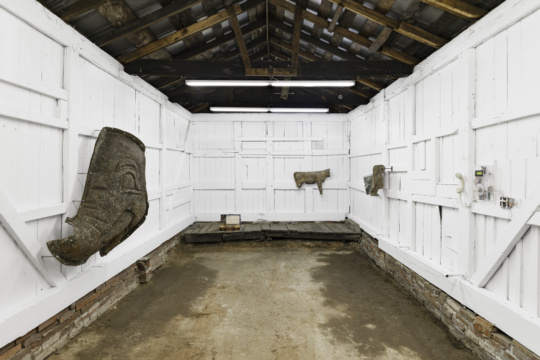[cont.]

There were several buildings connected by walkways that made up the Nexus complex (formerly Forrest Avenue Consortium), forming a squared-U with parking in the center. On the eastern corner was the smallest building – a one-story building that housed Nexus Press. The three-story central building housed the administrative offices on the first floor; rehearsal, an office/studio spaces, and an apartment on the second floor; and a huge gallery/workspace and loft space on the third (I was told this had been the gymnasium, which explained the high ceilings and beautiful wood floors.) The gallery had five exhibition spaces – the large main room, the square gallery, and the curved wall gallery (4,000 square feet of exhibition space), as well as loft spaces that ran along both sides above the main gallery. This central building also housed Nexus Theater, whose main entrance was on the second floor, with an exterior lift for accessibility – a fabulous space. Gary Super and Michael Goodman (later Clifton Meador) were running Nexus Press, and Jo Giraurdo (later, Ian McColl) ran Nexus Theater.
The two-story third building (and some of the central) was devoted to artist studios. Most artists were in classrooms, although some were in smaller spaces. And there was a sculpture studio with a side yard on the lower floor. Some of the artists working there during my time at Nexus included Pat Courtney, Mario Petrirena, Don Cooper, Amy Landesberg, Susan Loftin, Paul Nahoom, Benjamin Jones, Ann Holcombe, Annie Conn, Normando Ismay, Beth Bolgla, Philip Carpenter, Tina Dunkley, Ginger Birdsey, Victoria Greenhood, Suzy Ferriss, Jere Brookshire, Curtis Patterson, Pearl Cleage, Steve Steinman, and Steve Seaberg (and my apologies to those I’m leaving out). Georgia Art Busa revamped school bus that Georgia Council for the Arts used to tour its art collection around the state, maintained a storage space on the ground floor of the central building. Drivers included Annie Conn and Jeff Mather. I cleared out the space behind it to create a musty studio with a long slate blackboard, linoleum floors and high windows, which I occupied for six years.
Kelly Seed and Feed Marching Band raucously rehearsed on weeknights in a room on the second floor of the main building. For a period of time, there was an apartment on the second floor that writer Zeke Burnette lived in as the onsite security and maintenance supervisor.

In the fall of 1982, Cheryl Neal was the interim director until, after a search, the Nexus board of directors hired Louise Shaw (now curator at the CDC Sencer Museum) to be executive director. At the time, Louise was working as the curator of GSU Gallery. Elizabeth Lide, Leslee Samuelson, and Barbara Schreiber worked with Louise at various times in the administrative office, keeping everything running, bills paid, rent collected, payroll met, memberships recorded, grants and donations managed. I had many wonderful conversations over the years with the artists and others who worked in that office. One of my favorite memories of that arty-office is that Barbara dedicated a corner of her desktop for temporary installations that she curated.
Across the street from Nexus was Annie Keith’s, an unmarked but popular restaurant in one of the small bungalow houses along Ralph McGill where we’d all go for a fried chicken and vegetable lunch from time to time. Local TV and political personalities could occasionally be spotted among the diners. When you sat on the back porch, you would pay for your meal to a woman perched next to the stove in the kitchen window. At other times, we’d caravan to Eat Your Vegetables (also affectionately dubbed by one of my friends as Eat Your Wallet) in Little 5 Points.

Small and Important (December 3-23, 1982) curated by Amy Landesberg and Kiyoaki Kato, was the first show I helped to install. It included 23 artists from: “…Atlanta, the state of Georgia, the Southeast region, and the nation,” as the press release stated, such as Scott Belville, Rita Brenner, Linda Connor, Rev. Howard Finster, Glenn Eden, Susan Loftin, Nancy Marshall, John McWilliams, Jim Nutt, Nellie Mae Rowe, Steve Seaberg and Lucas Samaras.
The soaring windows that overlooked Ralph McGill Boulevard were stapled dark with black plastic. The 23 works were each spotlighted, spread throughout the three galleries, most one to a wall, dramatizing their presence. In my notebook, I described the lighting as “(dramatic, non-neutral) anti-museum.” Catherine Fox reviewed the exhibition in the Sunday, December 19th Atlanta Journal-Constitution in a piece titled “Mixed-media exhibit shows small works can be important,” concluding: “Small but [sic] Important” exemplifies what a group show can achieve when it is more than a random collection of artists. By providing a discourse on esthetic issues in a way that commercial galleries can’t, Nexus continues to assert its importance to Atlanta.”
For the next exhibition, which ran January 21 – February 19, 1983, Nexus Gallery had three solo shows: Criss Mills, Joseph Jachna and Emmet Gowin (As a photography student, I was in awe of the work of the latter). Jachna and Gowin were part of a Georgia State University exhibition featuring students of Harry Callahan.
Ephemera: An Internship at Nexus Gallery
Related Stories
Reviews
Daily
Reviews
As for me, I’m just passing through this planet at Bad Water, Knoxville
Harrison Wayne reviews the entangled sculptures and taxidermic specimens found in As for me, I’m just passing through this planet at Bad Water, Knoxville.
In the Studio with Chayse Sampy
Amarie Gipson visits mixed-media artist Chayse Sampy in her shared studio in Downtown Houston to discuss living in the South, Afro-surrealism, and the color blue.
Everyday Love by Richard Dial at Institute 193, Lexington
Daniel Fuller reviews the crafted metal chairs reflecting tenderness and the human condition in Everyday Love by Richard Dial at Institute 193, Lexington.




